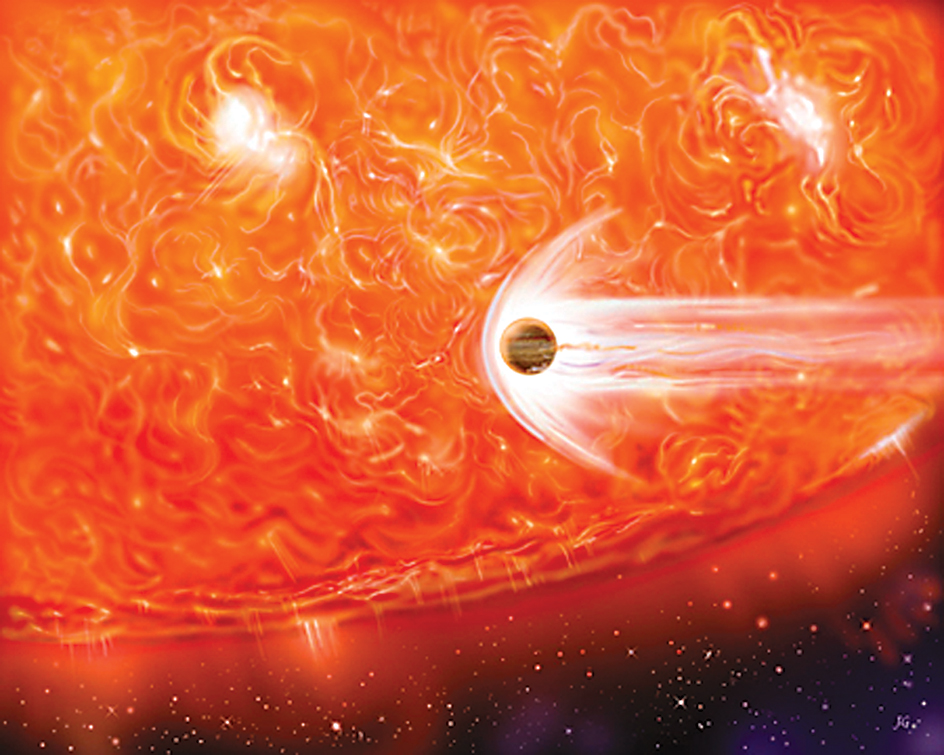Brown dwarf is a dim heavenly body that has more mass than a planet but less mass than a star . Mass is the amount of matter in an object. Brown dwarfs are all about the same size as the planet Jupiter , but they have from 13 to 75 times as much mass as Jupiter. Brown dwarfs are difficult to detect because they are so dim.

Stars and brown dwarfs form in the same way. A cloud of dust and gas shrinks under the force of gravity. A ball of gas forms at the cloud’s center. As the cloud continues to shrink, the ball heats up. When the core of the ball becomes hot enough, hydrogen atoms begin to fuse (join together). If the ball has enough mass—more than about 75 times the mass of Jupiter—fusion will continue. The object then becomes a star. If the ball has less mass, little fusion occurs. The object then becomes a brown dwarf.
As the brown dwarf continues to shrink, electrons in its core push against each other more strongly. This pushing creates pressure that works against the force of gravity. Eventually, the pressure equals the force of gravity. The brown dwarf stops shrinking and begins to cool. As the brown dwarf cools, fusion ceases. The brown dwarf’s temperature continues to drop, and its glow slowly fades.
The more mass a brown dwarf has, the hotter and brighter it begins. The hottest and brightest brown dwarfs glow a dull red. They resemble low-mass stars known as red dwarfs . To distinguish between a red dwarf and a brown dwarf, astronomers analyze light given off by the object for evidence of the presence of the element lithium. Stars destroy lithium, while brown dwarfs do not. The presence of lithium indicates that the object is a brown dwarf. As the brown dwarf cools, it less closely resembles a star. Once a brown dwarf’s surface cools below a starlike temperature, astronomers can easily distinguish it from a star. Heavier elements, such as iron and titanium, begin to form dust grains in the brown dwarf’s atmosphere.
As the brown dwarf continues to cool, it begins to more closely resemble a gas giant planet like Jupiter. Chemical reactions convert carbon monoxide gas in its atmosphere into methane.
Brown dwarfs can appear alone or in groups of stars called star clusters . Some brown dwarfs orbit companion stars. Astronomers have even identified pairs of brown dwarfs orbiting each other. (See Binary star .) Some brown dwarfs might also have planets orbiting around them.
Like Jupiter, brown dwarfs rotate rapidly, spinning completely around in just a few hours. Scientists believe the atmospheres of cooler brown dwarfs may be marked by bands of swirling gas, much like the atmosphere of Jupiter.
Since the 1970’s, astronomers have predicted that a large number of brown dwarfs exist. But astronomers were not certain that they had discovered any until 1995. Some scientists believe the number of brown dwarfs in the universe may be similar to the number of stars.
Calculations involving gravity predict that there is much more matter in the universe than we can see. Scientists once believed brown dwarfs made up much of this invisible matter, called dark matter . Astronomers have determined, however, that there are not enough brown dwarfs to account for much dark matter.
See also Red dwarf ; White dwarf .
